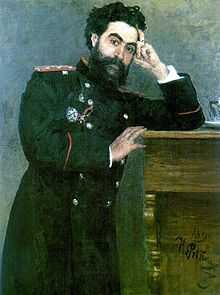Ivan Romanovich Tarkhanov

Ivan Romanovich Tarkhanov (Russian: Иван Романович Тарханов) or Ivane Tarkhnishvili (Georgian: ივანე თარხან-მოურავი; 1846–1908) was a Russian physiologist and science populariser from the Georgian Tarkhan-Mouravi noble family.[1][2][3] He led the Department of Physiology at the Academy of Military Medicine from 1877 to 1895 and authored a slew of articles on physiology for the Brockhaus and Efron Encyclopedic Dictionary.
Life
The precocious child of a Russian general active during the Caucasian War, Tarkhanov interpreted for Alexandre Dumas while the writer was visiting Tiflis in 1858. In the 1860s, he attended the University of Saint Petersburg, then joined Ivan Sechenov's laboratory at the Academy of Military Medicine. He pursued physiological experiments at the academy until his retirement in the late 1890s.
Tarkhanov died during a summer vacation in the Carpathians. His ornate tombstone is in the Alexander Nevsky Lavra.
Research
Tarkhanov is probably best known as a pioneer of radiobiology and electrophysiology. In 1889, he was the first to observe and document the psychogalvanic reflex, i.e., variations in skin electrical potentials in the absence of any external stimuli.[4]
After irradiating frogs and insects with X-rays in early 1896, several weeks after Röntgen's discovery, Tarkhanov concluded that these newly discovered rays not only photograph, but also "affect the living function". These experiments signalled the birth of radiobiology.[5]
In 1885 experiments on cutting and artificial emptying of the seminal vesicles, Tarkhanov showed that the latter played the crucial role in the generation of sexual excitement in frogs. Proceeding from these experimental results, Tarkhanov put forward a hypothesis that filling and evacuation of the seminal vesicles were the main biological cause which led to sexual arousal and its disappearance in mammals and humans.[6]
In the mid-1870s Tarkhanov visited major universities of Europe in order to get acquainted "with the state of the educational process, teaching systems, different laboratory devices".[7]
References
- ↑ "Tarkhanov, Ivan Ramazovich". thefreedictionary.com. Retrieved 21 January 2013.
- ↑ Tsagareli, M. G. (November 13, 2010). "Ivane Tarkhnishvili: Major Georgian figure from Russian physiological school" (PDF). Neuroscience Meeting Planner. San Diego, CA: Society for Neuroscience. pp. 26–27. Retrieved 21 January 2013.
- ↑ "Tarchanoff phenomenon". thefreedictionary.com. Retrieved 21 January 2013.
- ↑ Handbook of Clinical and Experimental Neuropsychology (eds. Gianfranco Denes, Luigi Pizzamiglio). Psychology Press, 1999. ISBN 9780863775420. Page 33.
- ↑ Y. B. Kudriashov. Radiation Biophysics. ISBN 9781600212802. Page xxi.
- ↑ Тарханов И. Р. К физиологии полового аппарата у лягушки (On Physiology of the Reproductive system in frogs). — «Русская медицина (Russian medicine)», 1885, №30–32, с. 1–26. See also in German: Tarchanoff, J. R., Arch. f. d. g. Physiol. des Mensches u. d. Thierc., 40, 330 (1887).
- ↑ http://books.google.com/books?id=JvDNN9z3PWgC&pg=PT25
Selected publications
- Tarchanoff, J. R., Arch. f. d. g. Physiol. des Mensches u. d. Thierc., 40, 330 (1887).
- Tarkhanov, I. (1896) Experiments upon the action of Roentgen’s X-rays on organisms. Izv. SPeterb. biol. Lab., 1, 47-52.
Further reading
- Todes, Daniel Philip (2002). Pavlov's Physiology Factory: Experiment, Interpretation, Laboratory Enterprise. Johns Hopkins University Press. ISBN 978-0-8018-6690-6.
- Tsagareli, Merab G. (2012). "Ivane Tarkhnishvili (Tarchanoff): A Major Georgian Figure from the Russian Physiological School". Journal of the History of the Neurosciences 21 (4): 393–408. doi:10.1080/0964704X.2012.670097. PMID 22947381.
- Broughton, R.J; Poiré, R; Tassinari, C.A (1965). "The electrodermogram (Tarchanoff effect) during sleep". Electroencephalography and Clinical Neurophysiology 18 (7): 691–708. doi:10.1016/0013-4694(65)90113-6.